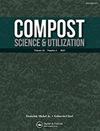Utilization of Bio-Municipal Solid Waste Improves Saline-Sodic Soils and Crop Productivity in Rice-Wheat
IF 0.9
4区 农林科学
Q3 ECOLOGY
引用次数: 5
Abstract
Abstract Solid waste management and soil degradation are the two main issues faced by the developing countries. The present study is the first effort to use bio-municipal solid waste (MSW) for the amelioration of saline-sodic soils of Pakistan. A pot experiment was conducted to evaluate the effects of MSW, farm yard manure (FM) and gypsum application on nitrate leaching, soil physicochemical characteristics and crop productivity under rice-wheat cropping system. The MSW was aerobically composted alone (MSW compost) or with FM (MSW_manure compost) or buried underground in lined pit for anaerobic decomposition (buried MSW) . Maximum nitrate leaching was observed during rice (84.91 mg L−1) and wheat (46.18 mg L−1) with buried MSW as compared with control treatment. Results showed that buried MSW significantly (p < 0.05) lowered the soil pHs (-5.6%), electrical conductivity (-38.8%), calcium carbonate (-45.8%), and sodium adsorption ratio (-51.4%) and significantly increased the organic matter (86.3%) and cation exchange capacity (31.50%) as compared with control treatment. Path analysis showed the highest direct path coefficient during rice and the lowest one during wheat. Soil amelioration with organic amendments was further confirmed with multivariate analysis. This study has proved that buried MSW can be used as an effective solution for MSW disposal thereby improving soil physicochemical properties and crop productivity from saline-sodic soil.利用城市生活垃圾提高水稻-小麦盐碱地和作物生产力
固体废物管理和土壤退化是发展中国家面临的两个主要问题。本研究首次尝试利用生物城市固体废物(MSW)改良巴基斯坦的盐碱土。通过盆栽试验,研究了稻麦轮作条件下城市生活垃圾、农家肥和石膏对硝酸盐浸出、土壤理化特性和作物生产力的影响。MSW单独进行有氧堆肥(MSW堆肥)或与FM(MSW_manure堆肥)或埋在地下的内衬坑中进行厌氧分解(埋置MSW)。水稻硝酸盐浸出量最大(84.91 mg L−1)和小麦(46.18 mg L−1)与埋置MSW处理相比。结果表明,填埋MSW显著(p < 0.05)降低了土壤pH值(-5.6%)、电导率(-38.8%)、碳酸钙(-45.8%)和钠吸附率(-51.4%),并显著提高了有机质(86.3%)和阳离子交换能力(31.50%)。通径分析表明,水稻期直接通径系数最高,小麦期最低。多元分析进一步证实了有机改良剂对土壤的改良作用。本研究证明,埋置MSW可以作为处理MSW的有效解决方案,从而改善盐碱土的土壤理化性质和作物生产力。
本文章由计算机程序翻译,如有差异,请以英文原文为准。
求助全文
约1分钟内获得全文
求助全文
来源期刊

Compost Science & Utilization
农林科学-生态学
CiteScore
4.10
自引率
0.00%
发文量
0
审稿时长
>36 weeks
期刊介绍:
4 issues per year
Compost Science & Utilization is currently abstracted/indexed in: CABI Agriculture & Environment Abstracts, CSA Biotechnology and Environmental Engineering Abstracts, EBSCOhost Abstracts, Elsevier Compendex and GEOBASE Abstracts, PubMed, ProQuest Science Abstracts, and Thomson Reuters Biological Abstracts and Science Citation Index
 求助内容:
求助内容: 应助结果提醒方式:
应助结果提醒方式:


